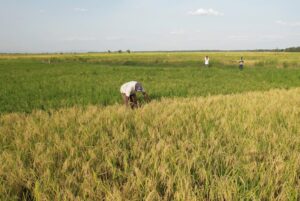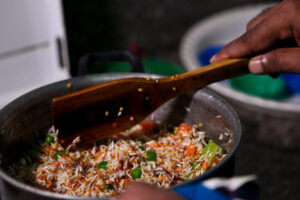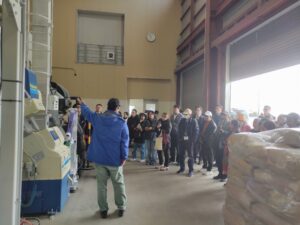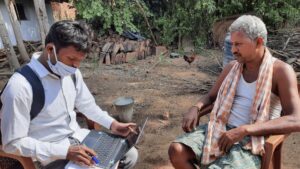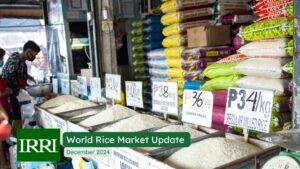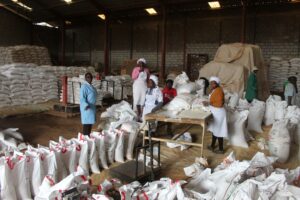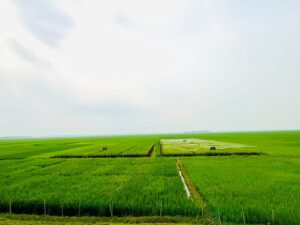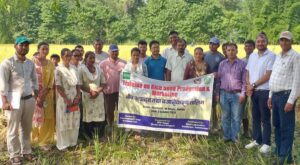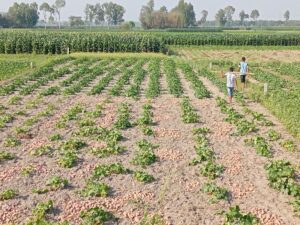
What is the true price of rice? Do we have enough rice to feed the growing population? Where will the rice in the future come from? What drives the global rice market? What are the game changers? These were just some of the questions raised by economists and other participants at the 2014 Global Rice Market and Trade Summit in Bangkok, Thailand, on 27-29 October.
Government policies, climate change, increasing population, migration of farmers to cities, and the rising middle class are some of the game changers in the global rice market that echoed among the speakers during the Summit.
Climate change
There was a note of concern on the projected impact of climate change on agriculture. Most agreed that rising sea levels, increasing soil salinity in farm areas, higher temperatures, and more frequent occurrence of floods and droughts will have great adverse effects on rice production.
In Asia, large areas of rice are grown in low-lying deltas and coastal areas such as the Mekong River Delta in Vietnam and the Ganges basin in Bangladesh and India. A 1-meter rise in sea level could wipe out these prime rice production areas.
With increasing sea levels, saltwater could penetrate more inland areas and contribute to soil salinity, thus radically reducing rice yields as most rice varieties are only moderately tolerant of salt.
Increases in temperatures will also decrease rice output. A study at the International Rice Research Institute (IRRI) indicates that a rise in nighttime temperature by 1 degree Celsius could reduce rice yields by about 10% while many varieties are sensitive to higher daytime temperature.
About 20 million hectares of the world’s rice-growing area are at risk of occasionally being flooded, particularly in major rice-producing countries such as India and Bangladesh.
Although more research is needed to tackle the challenges posed by climate change, IRRI has already developed several climate-smart rice varieties that have made huge impacts in unfavorable environments in Asia and Africa. IRRI Director General Robert Zeigler said the second Green Revolution is benefiting the marginalized sector of society— the poorest of poor farmers—who live in areas most vulnerable to climate change (see Green revolutions 2.0 and 3.0: No farmer left behind).
Booming population
There will be more mouths to feed in the future. The population is increasing, particularly in South Asia, where most of the world’s rice supply is grown. “Thirty percent of the global population growth in the next 5 years will be coming from this region,” said Dr. Suthad Setboonsarng, a Thai economist and currently member of the IRRI Board of Trustees. In addition, the number of nontraditional rice eaters is rising, especially in African countries. With global rice demand estimated to increase from 439 million tons in 2010 to 555 million tons in 2035, rice production must be able to keep up if world market prices are to be stabilized at affordable levels for billions of rice consumers.
Rising urbanization

The changing economic structure of Asia and the increasing number of its middle class will have an influence on the international rice market. “The higher the income of the people, the more diversified are their diets,” said Dr. David Dawe, FAO senior economist. “This change will have an effect on the demand for rice.”
And, 50% of this change is coming from India and China, according to Dr. Setboonsarng. China’s economic progress will result in mass outmigration from farms to cities. The rural migration will be massive, according to Milo Hamilton, senior agricultural economist and co-founder of Firstgrain.com. More than 250 million people in China will leave their farms and move into cities in the next 15 years. In China alone, 1 billion more people will live an urban life by 2030. This phenomenon is also occurring in other parts of Asia. Southeast Asian farmers are leaving rural areas for better wages in cities. For example, Cambodians in rural areas are migrating to the cities of Thailand to work in construction or in factories.
A worrisome question is who would be left on rice farms to feed the ever-growing cities that need increasing quantities of food, said Mr. Hamilton. “This is a double whammy on the rice market—increase in urban consumption and reduction of rural food sector workers,” added Dr. Setboonsarng.
Water and rice

According to Dr. Setboonsarng, the expansion of urbanization in Asia is leading to an increase in domestic consumption of water, which will compete with the use of water for agricultural production, especially rice production. It is a fact that rice is the most water-intensive crop. “Water, a limited resource, is diminishing,” Dr. Setboonsarng said. “The groundwater used to irrigate rice in countries such as Bangladesh, India, and China is stressed because of the expansion of irrigation.”
Mr. Hamilton said that rice production is more like water conversion. When one trades rice, one is also trading water. Samarendu Mohanty, IRRI senior economist, said that “when the government of India is subsidizing rice production, it is, in one way or another, subsidizing the water need of the country that buys the rice.” It is said that China has the capacity to produce more rice if it wants to, but, unlike India, it is conserving its water by importing rice.
This goes back to the issue of finding the true value of rice. Mr. Hamilton said that water, itself, is not usually priced but what is priced is the cost of obtaining the water. How we put a price on rice is akin to how we put a price on water. Water scarcity will have an effect on where the rice is coming from in the future. According to Mr. Hamilton, rice will be coming from countries whose water resource has not yet been depleted.
A political commodity
Since rice is the staple food of more than half of humanity, it is easy to understand that it is a political commodity. Governments will do everything possible to make rice available to their constituents. They have done a lot of things to control its price so their constituents or “voters” can still afford it, or buying from farmers at a higher price to encourage farmers to produce it. When the price of rice spiked during 2007-08, riots erupted in different corners of the world and posed tremendous challenges to many governments.
Government policies
The rice price crisis was a wake-up call for many governments. Many created policy interventions to prevent food crises from occurring again. For rice-importing countries such as the Philippines, Indonesia, and Malaysia, the policy is selfsufficiency. The Philippines is doing its best to increase its rice production through its Food Staples Sufficiency Program, at the same time encouraging its citizens to diversify their diets by eating carbohydrate alternatives such as sweet potato and cassava. In addition, the Philippine government launched national campaigns discouraging consumers from wasting rice.
But, “government interventions in the form of rice policies often hide the true price of rice,” said Dr. Mohanty. For example, the rice-pledging scheme of Thailand made the price of its rice less affordable—and less competitive—in the international rice market. India’s policy on rice subsidy makes rice production cheap for farmers so they can sell rice at a low price. With India’s low price, plus its bumper crop in 2013, it temporarily displaced Thailand as the top rice exporter in the world.
“The government intervention in rice policies is two-pronged,” explained Dr. Setboonsarng. “Most governments control the price of food, including rice, to keep the price low. At the same time, they subsidize the producer, especially the farmers to enable them to keep up with the production. And as a consequence, the indirect recipient of subsidies to farmers is, in fact, the rice consumer, not only in one’s own country but also in other countries. For the domestic rice market, low prices discourage innovation in the whole rice value chain—from production and marketing to storage and distribution.”
And what does this mean to the international rice market? “As both the exporter and importer control the consumer price of rice and subsidize rice farmers, the supply curve of rice is shifted and lowers the price and quantity traded in the international market,” Dr. Setboonsarng added. “As a result, the world rice market becomes small and volatile. Moreover, the self-sufficiency policy of most rice-importing countries adds to the uncertainty.”
Lack of transparency
“Another reason for uncertainty is the lack of reliable information,” said Bruce Tolentino, IRRI’s deputy director general for communication and partnerships. “Uncertainty in the global rice market leads to speculation, and speculation can lead to confusion and panic.” He also emphasized the importance of transparency as a key to a stable global rice market.
“In fact, the root cause of the 160% price increase during the 2007-08 rice crisis was not the lack of supply but a lack of transparency,” Dr. Zeigler pointed out. “And, those hundreds of millions of people who suffered are the poorest of the poor. That became the wake-up call for us.
“For many, they think that the wake-up call was to pay attention to production technology,” he continued “But for us, we needed to understand what was going on in the rice trade and what we could do to make a difference.”
Over the years, IRRI has been focusing its expertise on what drives the global market and the kind of information required to attain a stable environment. The Institute has been gathering data and information on the socioeconomic aspects of rice: how much rice is needed, what it takes to grow a good crop, what a good rice crop is, and what consumers want.”
The underlying foundation is that IRRI is viewed as an honest broker,” said Dr. Zeigler. “We don’t have a dog in the fight in rice trade. This allows us to provide unbiased and accurate information on rice production.”
IRRI has been developing state-of-the-art tools to provide timely and accurate estimates of rice production in Asia. “We have a suite of technologies on board,” he said. “First, we have a much better way of estimating the realizable yield of the rice crop using a crop growth model, a technology that we have been developing for the last 25 years. We have an extraordinarily accurate assessment of what a rice paddy is going to do.”

Dr. Zeigler added that, through satellite imagery, data can be gathered and processed in real time to obtain a good assessment of actual rice production. The real breakthrough is that IRRI now uses radar imagery, which can provide superior penetration capability through any type of weather condition, and this can be used in daytime or nighttime.
He explained that, unlike before, because most rice is produced during the monsoon season, all we got were beautiful pictures of clouds. With radar imagery, IRRI can obtain a very good assessment of rice distribution. It can collect data on soil, water, and temperature and even obtain a weekly estimate of rice area, and determine the time when rice was planted. And, combining all these with crop growth data, we can estimate the harvest. This timely and accurate information will remove much uncertainty around production.
“Rice demand can be determined by income growth and distribution, and government policy, among other data,” Dr. Zeigler said. “As a rice research institute, IRRI can contribute in providing highly accurate information on the rice crop. Having a good understanding of both the supply and demand side of the equation is an important part of having a stable rice trade.”
IRRI’s expanding role
Indeed, IRRI has an important role to play in the development of rice policies. A number of interventions that governments have made, although reasonable in the short term, such as making sure that rice is available so that people will not have riots on the streets, have long-term adverse impacts.
According to Dr. Zeigler, organizations such as IRRI and the International Food Policy Research Institute are well placed to help governments work through the implications of their policy choices. Those policy choices will have a dramatic impact on rice trade— locally, regionally, and in the overall global rice market.
“From our perspective, we see a transition from a strictly research orientation attending to the issues around how to produce more and better rice in a more sustainable way as a good starting point for moving to a much richer engagement with the global community,” he said. “We think that it is increasingly important that we bring an unbiased point of view to the table to help provide the information that the global community needs for an open and transparent rice trade.”
_________________________________________
Ms. Reyes is the managing editor of Rice Today.

